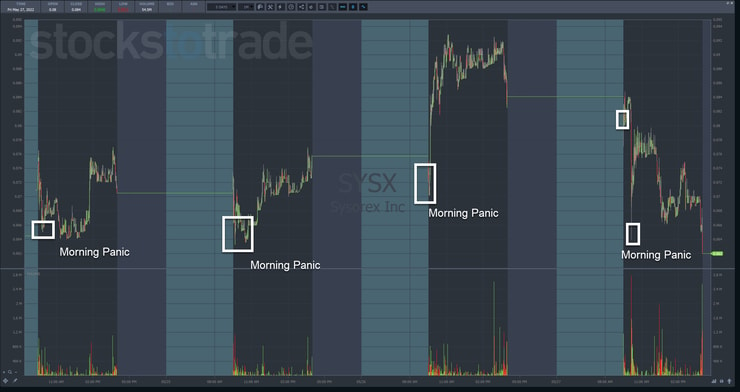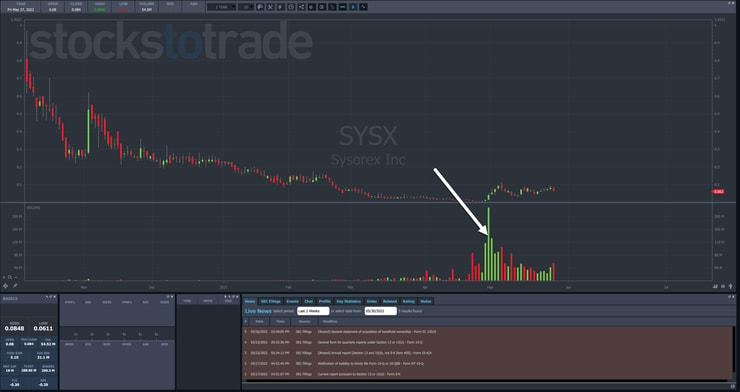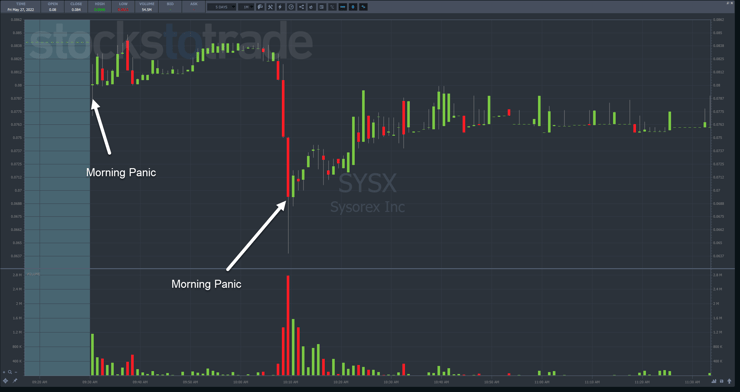My #1 goal is to help my students make money in the market, and KEEP IT.
And it’s why I’m particularly excited for Mark Croock to introduce his new Shadow Trades this Thursday. He’s got a totally unique way to trade this market that could be a game changer.
Now, one thing I taught Mark back in the day was to work with the market you have, not the one you want.
That’s why I dialed down my aggression and honed in on stocks like Sysorex Inc. (OTC: SYSX).
Right now, promoters are pumping up SYSX. Each time this happens, it creates morning panic selling, which sets up perfectly for a morning dip buy.
I traded this for a profit 4 times last week!
In the past, I’ve talked about who these promoters are and what they do.
Today, I want to take that a step further and use SYSX to show how this plays out in price action and where you can find trade setups.
Recognizing a Promoter Push
Let me start by saying that I don’t hate promoters. They serve a legitimate function in the market.
There are plenty of great companies out there that need to get in front of investors.
But there are just as many who use promoters to dump shares on unsuspecting investors.
I’m not here to judge one way or the other, just to explain how the game is played.
Many of these promoters rely on social media pumps including Twitter, Discord, and a host of other means.
I rely heavily on the StocksToTrade Breaking News Team to help identify these stocks.
Our analysts know exactly what to look for and call out when they find these companies.
Now, we can also identify promoter pushes by looking at what the company does and what news is out there.
Here’s the quick profile of SYSX:
“Sysorx Inc. is a company focused on Ethereum mining and the Ethereum blockchain technology solutions primarily in the public sector segments including federal, state, and local governments.”
Unless you’ve been living under a rock, you know that the once hot crypto sector has taken a beating lately.
Now, here’s something interesting from our news feed.
If you look at one of the most recent filings, you’ll find a report buried in the SEC about someone at SYSX unloading shares between $.02-.09 per share somewhere between March 1, 2022 and May 25, 2022.
Check out the daily chart of SYSX, and when volume and price started to increase on the stock.
That volume has yet to dissipate.
Regardless of the ethics or legality, these types of moves create tradeable opportunities.
Morning Dip Buy
Assuming I’ve identified a stock as a promoter push, I want to start looking for a pattern of morning panic selling.
You see, every time the stock gets pushed up overnight or in premarket, it provides these promoters or their clients a chance to sell into strength.
That sends share prices plummeting until they’ve unloaded their stock for the day.
When that happens, it can create an imbalance of buyers that rapidly send the stock back in the other direction.
Take a look at Friday’s price action to see what I’m talking about.
There were two opportunities I saw and traded.
The first came right out of the gate when the stock dropped on somewhat tepid volume.
It swung back in the other direction, made a quick high, and then fell back. From there, it traded sideways, a sign that any further upside was done for the time being.
The second swing came out of a heavy selloff that landed into support right around the low of the day from Wednesday.
Now, I don’t advocate for buying as the price is falling.
In fact, I waited for it to bounce before stepping in a bit past 10:10 a.m. EST.
I was looking for shares to bounce and volume to ease as it retraced part of that heavy drop.
Now, the swift drop in volume at 10:13 a.m. got me a bit skittish and I exited the trade for a profit. While that turned out to generate a small pullback, it was short-lived. SYSX pushed even higher.
Final Thoughts
Promoter stocks take some practice to identify. I look for toxic companies bouncing on news that shouldn’t lift them out of the sewers like garbage earnings, ownership changes, etc.
I can also do a quick search of social media sites like StockTwits, Twitter, and Discord to see if folks are hyping up the names unnecessarily.
Keep in mind, morning panics aren’t limited to promoted stocks. However, promoted stocks often provide these types of setups for several days until the volume dries up.
Now, if you’re looking to add some tools to your trading belt, I suggest you check out Mark Croock’s Shadow Trader, this Thursday.
Seats are limited.
—Tim




Leave a reply